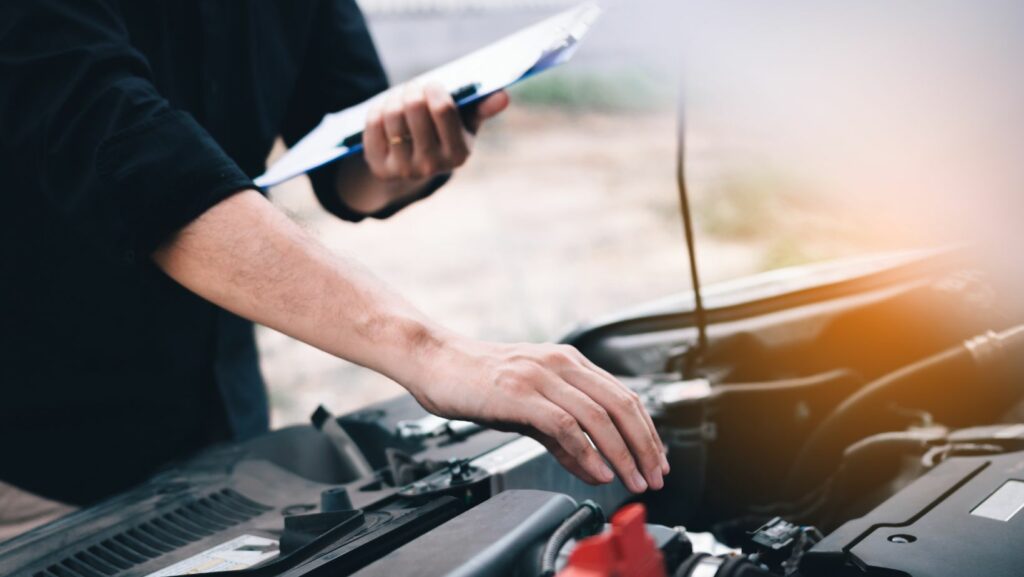Vehicle Care Basics
- Routine Maintenance is Essential: Regular oil changes, tire maintenance, and brake inspections are crucial to prolonging vehicle life and ensuring safety.
- Fluid Checks are Key: Monthly inspections of coolant, brake, and transmission fluids help maintain optimal vehicle performance and prevent overheating or mechanical failures.
- Tire Care Enhances Safety: Monitoring tire pressure and performing regular rotations can improve fuel efficiency and extend tire lifespan, contributing to a safer driving experience.
- Battery Upkeep Prevents Breakdowns: Regularly checking battery connections and testing voltage can prevent starting issues, particularly in extreme weather.
- Seasonal Preparations Matter: Adapting vehicle care routines to seasonal changes, like using winter tires or checking air conditioning before summer, improves performance and safety.
- Cleaning and Detailing Preserve Value: Maintaining clean interiors and exteriors helps protect the vehicle’s surfaces and enhances overall comfort and aesthetic appeal.

Every vehicle owner knows that proper maintenance is key to keeping their car in top shape. Understanding vehicle care basics not only prolongs the life of the vehicle but also enhances safety and performance. With a few simple practices, anyone can ensure their car runs smoothly and efficiently.
From regular oil changes to tire rotations, establishing a routine can save money and prevent unexpected breakdowns. It’s not just about keeping the car looking good; it’s about creating a reliable mode of transportation that can handle the demands of daily life. Whether you’re a seasoned driver or a new car owner, mastering these essential maintenance tips will provide peace of mind on the road.
Vehicle Care Basics
Vehicle care encompasses a variety of essential maintenance tasks. Regular attention to these tasks ensures safety and enhances vehicle longevity.
Regular Oil Changes
Regular oil changes prevent engine wear and enhance performance. Owners should change the oil every 3,000 to 5,000 miles, depending on manufacturer recommendations and oil type.
Tire Maintenance
Tire maintenance includes checking tire pressure, tread depth, and performing rotations. Maintaining a pressure level recommended by the manufacturer promotes fuel efficiency. Rotating tires every 5,000 to 7,500 miles balances wear and extends their lifespan.
Brake Inspection
Brake inspection is crucial for road safety. Drivers should check brake fluid levels monthly and have pads and rotors inspected every 10,000 miles. Signs of wear include squeaking sounds or decreased responsiveness.
Fluid Levels
Regular checks of fluid levels, including coolant, transmission, and brake fluid, maintain vehicle functionality. Normal coolant levels should be checked seasonally to prevent overheating, while transmission fluid should be replaced per the vehicle’s service schedule.
Battery Maintenance
Battery maintenance involves inspecting connections and cleaning terminals. Owners should replace batteries every 3 to 5 years. Signs of battery issues include dimming headlights or difficulty starting.
Wiper Blade Replacement
Wiper blades must be replaced annually for optimal visibility. Drivers should check for wear or tear before rainy seasons. Proper functioning improves overall driving safety.
Exterior Care
Exterior care protects against rust and maintains appearance. Washing the vehicle regularly and applying wax every three months creates a protective layer against environmental damage.
Interior Maintenance
Interior maintenance ensures comfort and hygiene. Owners should vacuum regularly and clean surfaces with appropriate materials. This helps to preserve the vehicle’s value over time.
By adhering to these vehicle care basics, owners enhance performance, prolong lifespan, and ensure a safer driving experience.
Importance Of Vehicle Maintenance
Vehicle maintenance plays a crucial role in ensuring safety and cost-effectiveness for car owners. Regular upkeep not only enhances performance but also safeguards against unexpected breakdowns.
Safety Considerations
Safety considerations significantly benefit from routine vehicle maintenance. Proper maintenance prevents mechanical failures that could lead to accidents. Regular inspections of brakes, lights, and tires ensure optimal functionality. For example, worn tires reduce traction, increasing the risk of skidding on wet surfaces. Additionally, maintaining fluid levels—such as brake fluid and coolant—ensures the vehicle operates efficiently while minimizing the chance of overheating or loss of braking power.
Cost-Effectiveness
 Cost-effectiveness stems from proactive vehicle maintenance practices. Regular oil changes prevent engine wear, extending the lifespan and performance of the engine, thus avoiding costly repairs. Tire rotations and alignments not only maximize tire longevity but also improve fuel efficiency.
Cost-effectiveness stems from proactive vehicle maintenance practices. Regular oil changes prevent engine wear, extending the lifespan and performance of the engine, thus avoiding costly repairs. Tire rotations and alignments not only maximize tire longevity but also improve fuel efficiency.
For instance, correctly inflated tires can enhance gas mileage by up to 3%. Performing maintenance tasks consistently reduces the likelihood of major repairs, allowing owners to save significant amounts on unexpected expenses. Following a maintenance schedule not only keeps vehicles running optimally but also preserves their resale value, making it an essential aspect of vehicle ownership.
Key Vehicle Care Practices
Maintaining a vehicle requires consistent attention to several fundamental practices. These methods enhance safety, performance, and longevity.
Regular Inspections
Regular inspections play a crucial role in vehicle care. Performing a comprehensive evaluation of key components like brakes, lights, and tires ensures all systems function correctly. Scheduling inspections every 6 months or according to the manufacturer’s recommendations promotes early detection of potential issues, minimizing costly repairs and enhancing safety.
Fluid Checks and Changes
Fluid checks and changes maintain essential vehicle systems. Engine oil, coolant, brake fluid, and transmission fluid levels should be examined monthly. For oil, a change every 3,000 to 5,000 miles prevents engine wear. Other fluids typically require changes based on the manufacturer’s guidelines, which helps ensure optimal functionality and vehicle reliability.
Tire Maintenance
Tire maintenance significantly impacts safety and fuel efficiency. Monitoring tire pressure monthly keeps tires inflated to manufacturer specifications. Regular rotation every 5,000 to 7,500 miles promotes even wear and extends tire life. Additionally, checking tread depth ensures adequate traction for safe handling on various road conditions.
Battery Care
Battery care prevents inconvenient breakdowns. Regularly inspecting battery terminals for corrosion helps ensure a proper electrical connection. Testing battery voltage every year provides insight into its health. If the battery shows signs of weakening, such as slow engine cranking, replacement serves as a proactive measure to avoid starting issues.
Cleaning And Detailing Your Vehicle
Maintaining a clean vehicle enhances aesthetics and protects surfaces from damage. Regular cleaning and detailing keep the vehicle’s interior and exterior in top condition.
Interior Cleaning Tips
- Vacuum Regularly: Regular vacuuming removes dirt, dust, and debris from seats and floor mats. Focus on difficult-to-reach areas, like under the seats.
- Wipe Surfaces: Use soft microfiber cloths with appropriate cleaning solutions to wipe down dashboards, door panels, and center consoles. This prevents buildup and keeps surfaces looking new.
- Clean Fabric Upholstery: For fabric seats, use a fabric cleaner and a soft brush to eliminate stains and odors. Ensure proper drying to avoid mildew.
- Shampoo Carpets: Shampoo carpets at least twice a year to remove ingrained stains and allergens. Ensure they’re thoroughly dried after cleaning.
- Protect Leather: Use a specialized leather cleaner and conditioner for leather seats. This maintains flexibility and prevents cracking.
- Organize and Declutter: Remove unnecessary items and use organizers for better management. This maintains a clean and functional interior space.
- Washing Routine: Wash the vehicle every two weeks using a pH-balanced car wash solution. Focus on removing dirt, grime, and road salt.
- Wax Application: Apply wax every three months to protect the paint and enhance shine. This shields against UV rays and environmental contaminants.
- Detailing the Wheels: Clean wheels with a dedicated wheel cleaner and brush. Pay attention to brake dust, ensuring they’re spotless and safe.
- Glass Care: Regularly clean windows and mirrors with glass cleaner to maintain clarity and visibility. Avoid streaks by using a lint-free cloth.
- Headlight Restoration: Restore foggy headlights with a headlight restoration kit to improve visibility. This increases safety during night driving.
- Trim Maintenance: Treat plastic and rubber trim with protectants to prevent fading and cracking. Regular care keeps exterior components looking fresh.
By following these cleaning and detailing practices, vehicle owners can preserve their vehicles’ appearance and longevity while ensuring comfort and safety for all passengers.
Seasonal Vehicle Care Tips
Seasonal vehicle care plays a crucial role in maintaining optimal performance and safety. These tips address specific challenges that arise in winter and summer.
Winter Preparations
Winter weather poses unique challenges for vehicles. Car owners should check antifreeze levels, ensuring the coolant system functions efficiently in cold temperatures. Examine tire tread depth and consider switching to winter tires for improved traction on icy roads. Inspect wiper blades, ensuring they can handle snow and rain, and replace them if worn.
Update the vehicle’s battery by checking terminal connections and testing voltage. Cold weather strains batteries, and a failing battery can lead to starting issues. Additionally, keep an emergency kit in the vehicle, including blankets, a flashlight, and non-perishable food, to prepare for unexpected situations.
Summer Maintenance
Summer maintenance is essential for vehicle longevity and performance. Begin by checking tire pressure, as it can increase with rising temperatures, affecting fuel efficiency. Rotate tires every 5,000 to 7,000 miles to promote even wear.
Inspect the air conditioning system to ensure it operates effectively during hot weather. Replace cabin air filters annually for improved air quality inside the vehicle. Monitor fluid levels, especially coolant and brake fluid, to prevent overheating and maintain safety.
Consider detailing the vehicle with a thorough wash and wax, protecting the paint from sun damage and road debris. Regularly check for any signs of wear on belts and hoses to avoid breakdowns during summer road trips.
Essential for Every Car Owner
Prioritizing vehicle care is essential for every car owner. By implementing a regular maintenance routine and staying proactive about inspections, individuals can significantly enhance their vehicle’s performance and safety. Simple practices like checking fluid levels and maintaining tire health can prevent costly repairs down the line.
Additionally, seasonal care ensures that vehicles are prepared for changing weather conditions. Keeping the car clean and well-maintained not only preserves its appearance but also contributes to a safer driving experience. Embracing these vehicle care basics will lead to a reliable and efficient mode of transportation for years to come.

